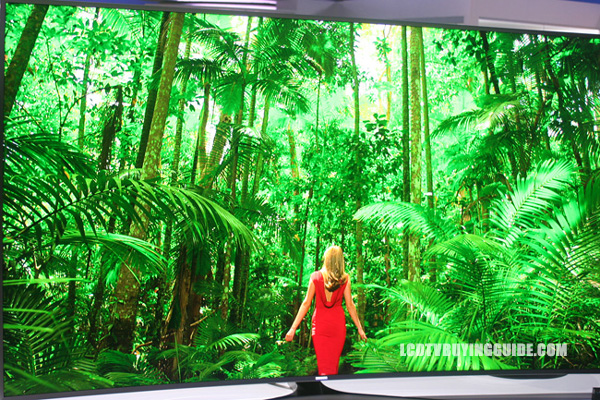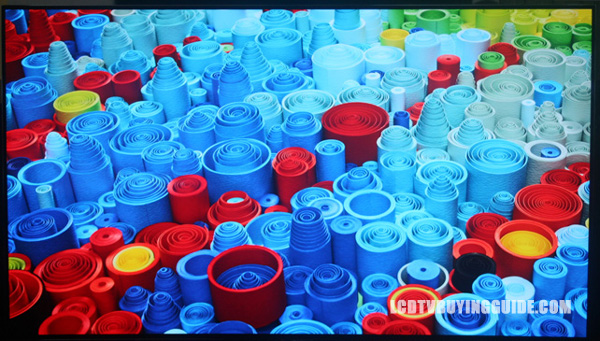SUHD TV (Samsung) vs. UHD 4K TV vs. OLED TV (LG) 2015
What is SUHD? What Makes an UHD TV a Samsung SUHD TV?
by Robert Wiley, Jack Burden, and Phil Conner
For 2015 and 2016 Samsung has a new moniker for it's 4K TVs. Why be plain when you can spice things up a bit? It's SUHD. The “S” stands for Super. Alright, here are the particulars on what makes an SUHD. First, there is a new color system used called DCI P3 which has a wider color gamut or spectrum or pallet – call it what you will it's a bigger range of colors. That color is dispursed and presented further by the Nano Crystal Technology which is a competing technology to Quantum Dot technology used by some of the other OEMs. The combination of the two does improve the color. It comes across more refined, cleaner and more defined than the previous 4K TVs. To me, it's a 10% improvement in color representation. Next, the SUHD lineup has a brigher backlight which is capable of hitting 1000 nits at peak brightness and produce deeper blacks as well, though this is more difficule to discern. Last, all SUHD TVs in Samsung's lineup have the proprietary Samsung developed Tizen operating system for Smart TV though that's not part of what differentiates an SUHD. SUHD is all about those upgraded UHD picture quality features.
With all this work, Samsung has come a long way in catching Sony which produced the best 4K UHD TVs in 2014 (at great expense for the top models).
We asked Samsung at CES 2015 if they would be producing any OLED TVs this year and the answer was an emphatic, “No”. Instead, here are the particulars on what makes a Samsung SUHD. First, there is a new color system used called DCI P3 which has a wider color gamut or spectrum or pallet – call it what you will, it's a bigger range of colors. That color is dispursed and presented further by Samsung's Nano Crystal Technology which is a competing technology to Quantum Dot technology used by some of the other OEMs. The combination of the two does improve the color. It comes across more refined, cleaner and more defined than the previous 4K TVs. To me, it's a 10% improvement in color representation when displaying 4K content. Next, the SUHD lineup has a brigher backlight which is capable of hitting 1000 nits at peak brightness and produce deeper blacks as well, though this is more difficule to discern. Last, all SUHD TVs in Samsung's lineup have the proprietary Samsung developed Tizen operating system for Smart TV though that's not part of what differentiates an SUHD. SUHD is all about those upgraded UHD picture quality features, particularly the widened color gamut through Nano-Crystal, the brighter LED backlight, and the DCI P3 color system.

Samsung's curved UN65JS9500 SUHD
Comparing the new Samsung SUHD TVs to LG's new OLED 4K TVs, let's get the technical aspects out of the way first. OLED 4K UHD TVs do not have an LED backlight. Instead, OLEDs (organic light emitting diodes) are each lit (by electrodes). In other words the pixels have their own phosphorescence. Read more about OLED vs. 4K UHD TV here.
Qualitatively, we continue to see OLED 4K as having a clear advantage over all types of LED backlit 4K UHD TVs. Sony and other manufacturer's last year told us that they were having problems with OLED in terms of reliability. But LG is taking OLED 4K all the way in 2015 with many models being introduced and if the reliability reports turn out favorable we expect them to fare exceptionally well in this interesting TV technology war. Expect a big marketing push from Sony, Samsung, Sharp, and Panasonic promoting 4K UHD (and SUHD) TV technology while downplaying OLED technology.
LG's OLED 4K advantages are very similar to the benefits of plasma over LCD TVs. They have better side viewing angles, better black levels, no problems with backlight uniformity interfering with contrast. And in fact the colors on OLED TVs are just more beautiful to me. I believe all of these wider color gamut technologies employed by Samsung and others, are simply to make them more OLED-like in their color presentation.

LG's curved 4K OLED TV 55EG9600
Perhaps what should be the biggest consideration is often overlooked. Which TV technology and manufacturer is going to present 1080p, 720p, and 480p . We always view these top tier TVs in their best light with premium 4K UHD content pumped in. But how do they handle normal high def and standard def signals? This will certainly vary by the upscaling technology employed by each manufacturer, but I believe OLED 4K has a clear advantage here as well as there is less work the TV's processing engine must do to produce excellent contrast and color. However, we recognize that a truly superb processing engine (witness last year's Sony XBR-X950B series) will win out in any screen over poorer processing.









